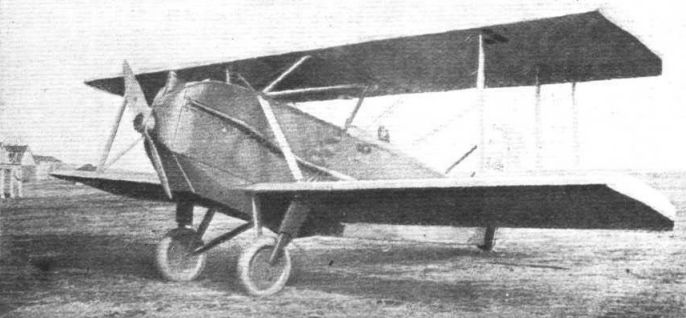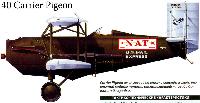Curtiss Model 40 Carrier Pigeon
Прототип Carrier Pigeon (позднее Model 40), построенный для участия в конкурсе, объявленном почтовой службой США, появился в 1925 году. Самолет представлял собой небольшой одностоечный биплан с размахом верхнего крыла меньше, чем у нижнего, и хвостовым оперением с расчалками. Самолет имел смешанную конструкцию - деревянные крылья и фюзеляж из сварных стальных труб с полотняной обшивкой. Необходимость взлета и посадки на неподготовленных аэродромах нашла отражение в прочной конструкции шасси с широкой колеей и независимыми стойками.
В 1926 году для авиакомпании "National Air Transport" построили 10 Carrier Pigeon, компания приобрела и прототип.
Carrier Pigeon II появился в 1929 году. Три таких самолета изготовили для "National Air Transport". Как и его предшественник, самолет являлся одноместной почтовой машиной, но напоминал самолеты серии Falcon. На нем стоял V-образный двигатель Curtiss G1V-1570 мощностью 600 л.с. (447 кВт) с жидкостным охлаждением.
ТАКТИКО-ТЕХНИЧЕСКИЕ ХАРАКТЕРИСТИКИ
Curtiss Model 40 Carrier Pigeon I
Тип: одноместный почтовый самолет
Силовая установка: V-образный поршневой двигатель Liberty 12 мощностью 400 л.с. (298 кВт)
Летные характеристики: максимальная скорость 201 км/ч на оптимальной высоте; крейсерская скорость 169 км/ч; начальная скороподъемность 244 м/мин; практический потолок 3900 м; дальность полета 845 км
Масса: пустого самолета 1634 кг; максимальная взлетная 2549 кг
Размеры: размах нижнего крыла 12,78 м; длина 8,78 м; высота 3,68 м; площадь крыльев 46,91 м2
Полезная нагрузка: до 454 кг почты
Показать полностьюShow all
Flight, April 1925
THE CURTISS "CARRIER PIGEON
A New Machine Built Specially for Overnight Air Mail Service
ALTHOUGH the U.S. Transcontinental Air Mail Service, especially with the night flying section, has proved to be extraordinarily successful, not only as regards the operation of the service itself, but also on account of the increasing patronage by the public of this very much speedier method of delivering mails, the Post Office Department now find the need for larger, more efficient and safer machines than those at present in use - converted war-type D.H. biplanes. The latter, it must be admitted, have nevertheless given excellent results during the four or five years the U.S. Air Mail Service has been in operation, in spite of the fact that the design of these machines is over eight years old.
With this demand in view, therefore, the Curtiss Aeroplane and Motor Co., of Garden City, N.Y., has designed and produced what is claimed to be the first machine in America specially adapted for air mail work. This machine, which is called the "Carrier Pigeon," will carry half a ton of mail (about 40,000 letters) or parcels. It is intended for operation on the night service between New York and Chicago, which will be inaugurated during the summer of this year. Using the same power plant - the 100 h.p. "Liberty" - it will carry, at a decreased cost and an increased speed, twice the load carried by the present machines. Having a cruising speed of over 100 m.p.h., it will make the trip between New York and Chicago with but one intermediate stop.
The "Carrier Pigeon" is a two-bay tractor fuselage biplane having an exceptionally deep body. Its high speed is about 120 m.p.h., and it will climb at the rate of more than 1,000 ft. per minute, its service ceiling being over 15,000 ft., thus enabling it to surmount with ease high mountain ranges. At the same time, it will land at less than 50 m.p.h. Carrying 117 gals, of fuel, it is capable of flying 500 miles non-stop. Fully loaded, it weighs 2 1/2 tons, of which a little less than a ton may be termed useful load - consisting of 1,000 lbs. of mail, 700 lbs. of fuel, with an allowance of well over 200 lbs. for pilot, parachute and other gear.
A considerable amount of thought and study has been spent in the production of this machine, including conferences with mail service officials and pilots, wind tunnel tests, weight calculations, detailed stress analysis, static lists and work on final choice of detail design. In the design of the "Carrier Pigeon," three important qualities were kept in mind - strength, serviceability, and ease of maintenance, all of which, it would seem, have been realised in the finished product.
The wings of the "Carrier Pigeon" are of wood and steel construction fabric covered. The upper and the lower wings are so designed that they are interchangeable, no centre wing section being required. The wing spars are of solid routed spruce, with no glued joins to deteriorate. The ribs are of Warren truss design giving a tested strength well over the maximum required in the machine. The factors of safety of the wing structure average 25 per cent, over that required in the design. Not only have the main structural members of the wings been carefully analysed for strength but also every detail fitting and bolt. This is also true, of course, of all other parts of the structure. "Sidewalk" panels of ample size have been provided on the wings for use in working on the machine and in handling the mail. All movable parts, such as aileron hinges, control joint connections, etc., are provided with bronze pins of ample size to guard against rusting or excessive wear. All interplane and tail struts are made adjustable to assist in the proper line-up of the ship.
The tail surfaces have the same general shape and are similar in construction to the wings, All control surfaces are of such a size as to insure adequate control at all speeds. The factors of safety in the tail, owing to the deep tail surfaces, are unusually high, being in some cases over three times the ultimate required. The rudder, elevators and ailerons are identical, being interchangeable one with the other, reducing the number of spares to a minimum. The right and the left stabiliser ore interchangeable, as are the ribs in both the fin and stabiliser. The stabiliser is made adjustable in the air. By a torsion and screw member running in bronze bearings, reducing the maintenance below that usually required in the chain and sprocket type The tail bracing in all above the stabiliser to preclude the possibility of breakage during getaway.
In order to insure the utmost safety to the crew, the fuselage skeleton and the motor mount have been constructed of welded steel tubing, using a Warren truss construction dispensing with the usual wires, which require periodical adjustment. The mail compartment has been located on the centre of gravity of the aeroplane insuring proper balance at any mail load from 50 lb. to 1,000 lb. The mail compartment is accessible from the side as well as from the top by means of hinged doors of such size as to admit very bulky packages. Loading and unloading of mail has been facilitated to a high degree. In addition to the water-tight mail compartment a private luggage compartment has been provided for the pilot's personal use. It is readily accessible from the ground. Inspection doors have been provided on either side of the fuselage to permit of easy access to the control system, tail skid, etc.
Special attention has been paid to the design of the landing gear and tail skid. The former uses the rubber "doughnut" type of shock-absorbing medium so popular on the "Hawk" (PW8) 'planes. The gear is decidedly "axleless," as can be seen from the accompanying illustration, and the danger of the axle fouling brush, hay, snow, etc., is, of course, reduced to a minimum. The wheels are oversize. The tail skid proper is a large high-tensile steel tube. It is steerable and sprung to give the easiest possible shock-absorbing qualities.
The engine is the Liberty 12 with all latest improvements. The radiator is the underslung type and fairs directly into the body lines. Shutters controlled from the cockpit are provided. The oil temperature is regulated by the same type of cooler used on all Curtiss service and racing machines. Although not found necessary on Liberty engines, it is considered by the designer to be a desirable feature for an aeroplane requiring the utmost reliability, as is the case in a machine of this type. The petrol tank, located under the mail compartment and also faired into the fuselage lines, is droppable in flight, an insurance against fire in case of an imminent crash. By means of special hood fasteners the cowling over the motor can be completely removed, exposing the interior of the engine compartment, and replaced in less than two minutes.
The petrol and oil-filler caps extend outside the fuselage, being far easier to fill than on an automobile. Special attention has also been paid to all drains. They are so located and of such a size that the ship can be completely drained of all water, petrol, and oil in a few minutes. A 7-quart fire extinguisher piped to the engine compartment is provided. This compartment has been made practically air-tight, ensuring complete smothering in case of a fire. The motor mount is, of course, removable, requiring only disconnection of petrol line, motor controls, and four hinge-pins to remove all the power plant excepting the petrol tank. The petrol lines, wiring and pressure-gauge lines run in a removable tunnel on the outside of the machine, rendering them readily accessible. Doors have been provided in the fire-wall to allow of easy access to water pump, distributor heads, and other parts of the engine.
The seat is made especially for use with a parachute, and in addition is shaped to fit the pilot's body. It is adjustable to accommodate pilots of different sizes. Arm rests, made adjustable, are installed for the comfort of the pilot. The rudder control is by means of pedals with swivelling footrests. The control column can be instantly changed to either stick or wheel control to suit the convenience of the pilot. The aileron control is of the "differential" type, ensuring adequate control even at stalling speeds. The ailerons are also so lined up that each side is an independent unit. The master ailerons are on the top wing, obviating the use of protruding horns on the lower wing, and ensures partial control even though the lower aileron is wiped off. "Alemite" lubrication has been provided on all movable parts, including controls, landing gear, tail skid, etc. The instrument board is conveniently located and is lighted by both "sky lights" and instrument lights. A petrol level gauge located in the cockpit shows the true level at any time. The pilot's cockpit is raised well above the fuselage, ensuring proper vision in all directions.
The principal characteristics of the "Carrier Pigeon" are :-
Span 39 ft. 1 1/2 ins. (top), 41 ft. 11 ins. (lower).
Chord 6 ft. 6 ins.
Gap 7 ft.
Dihedral (lower) 2°.
Wing section U.S.A. 27.
Overall length 28 ft. 9 1/2 ins.
Wing area 505 sq. ft.
Area of tail plane 65-5 sq. ft.
,, fin 28-1 sq. ft.
,, ailerons 53-6 sq. ft.
,, elevator 26-8 sq. ft.
,, rudder 13-4 sq. ft.
Weight empty 3,045 lbs.
,, loaded 4,900 lbs.
Weight/sq.ft. 9-78 lbs.
Weight/h.p. 12-29 lbs.
Speed range 50-120 m.p.h.
Climb 1,020 ft./min.
Absolute ceiling 16,700 ft.
Range 630-725 miles, or 8-9 hrs.
Показать полностьюShow all






